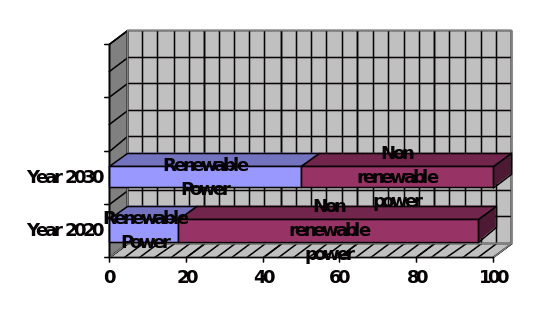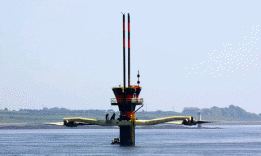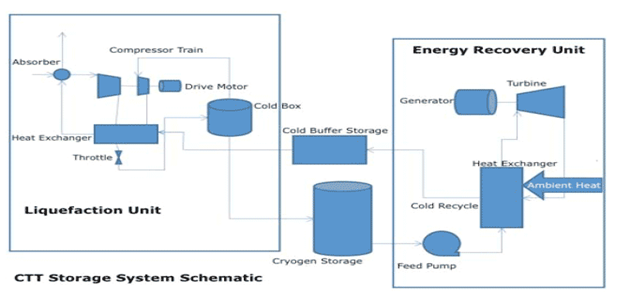Scotland’s efforts to utilize renewable energy resources continue to puzzle the world. The country has taken meticulous care to plan for its energy needs both for the present and for the future about sustainable management of natural resources as well as environmental protection. Some of these needs include the generation of energy from renewable sources for its domestic use as well as export. Scotland is aiming to progressively establish mechanisms for regeneration of energy sources and with time, close some of the non-renewable energy supplies. This is in line with its effort to be self-sufficient while taking care of its natural environment.
While at it, there will be two factors to consider in the regeneration of energy in Scotland. Firstly, Scotland will have to ensure that the project is economically viable. As such, the cost of regeneration of energy must not be greater than the economic worth of the project. Thus, the project must not only be economically viable but also environmental and socially relevant. Secondly, project engineers must ensure that the implementation of the project does not affect the technical deliverability of energy in Scotland. This means that the project must guarantee a regular supply of energy.
Credible research has concluded that Scotland can have efficient and reliable renewable energy production by the year 2030. This is after consideration of all factors necessary for the project such as wind solar and tidal wave, the economics of the project, the technical aspects, and both the internal and external markets for regenerated energy (Hassan 2010). As such, the project is aiming at avoiding the utilization of energy sources that increases the levels of carbon in the atmosphere. A review of how the regeneration of energy sources will influence demand and supply is highlighted in the first part of this paper.
The consequences of the project are evaluated carefully as well as optimal options to reduce the negative impacts of the project. Lastly, energy storage facilities will be described. While there are many risks involved in this project, this report endeavors to describe the most viable options for the regeneration of energy in Scotland. The table below shows renewable energy targets by the year 2030.

For Scotland to achieve its renewable energy goals by the year 2030, it has to consider the implications of implementing a policy that will control the demand and supply mechanisms for energy. The Scottish government along with other stakeholders is therefore called into action to ensure its success. Several policy issues concerning energy generation and supply have been formulated. These policies are aimed at ensuring that the project operates at an optimum level for optimum returns. Managing demand is informed by the fact that reducing electricity usage may not necessarily reduce the levels of carbon emission.
However, if wastages are kept at the minimum then the country will have made a significant step towards decarburizing energy use. Reducing energy wastage will also require the involvement of the public by encouraging it to change behavior that will enhance the proper use of electricity and other forms of energy in homes. Already several initiatives have been taken to educate the citizens, energy suppliers, business people, and property owners on the need to observe energy-saving practices as a way of decarburizing Scotland energy (CIH 2007).
One of the key policies will involve regulation of electricity use at home during peak and off-peak hours. It is estimated that electricity is used maximumly from morning to late afternoon. The government will encourage homes to use heat pumps for heating purposes. To control the use of heat pumps, owners of a commercial building will be encouraged to switch back peak hours an hour or two every morning, and then activate the heating pumps. Buildings have an innate ability to store thermal energy, which will help maintain necessary warmth in buildings throughout the day. This will greatly reduce the amount of energy used for heating. (Hassan 2010). The figure below shows a diagrammatic representation of the heat pump mechanism.

Property developers have also been approached with a new proposal to ensure that they acquire new building technologies that encourage sufficient energy use as well as using less carbon-based energy sources. Property owners as well suppliers of energy will need accurate data on energy uses. This cannot be achieved with the current equipment and thus new technologies need to be installed especially in measuring energy usage.
The Scottish government has therefore made the necessary plans to have homes and businesses installed with electricity meters that can measure and provide real-time data on electricity in homes and industries. Planning for the establishment of the new house will be vital, taking care of the available resources, the cost implications, and the marketability of the search home. Eco homes, despite being expensive are proving to be popular with homebuyers. However, there is a need to have a short-term solution to develop a cheaper eco home for immediate and short-term use.
The need to move progressively towards zero-carbon zones has seen Scotland manage its greenhouse gas emission substantially in line with the EU Emissions Trading Scheme. This has been done through several actions. Scotland has moved its Nitric Acidic Production plant to Dublin, Ireland and as a result, the emission of nitrous-based oxides has decreased significantly. The country has also reduced the number of livestock and developed management schemes for its landfill greenhouse emissions. The general result is a reduction in emission of greenhouse gases by 18%.
Lastly, industry regulators have noted that to realize efficient utilization of renewable energy, there is a need for suppliers to adopt an electricity load balancing mechanism. This will focus on the adoption of managed pricing controls. Electricity pricing will be done to manage its demand in terms of time (peak and off-peak), user type, and regional demand, and prices adjusted accordingly. Each of these demand types will have varied prices to regulate usage (The Scottish Government 2009).
Impacts of Regeneration of energy in Scotland
Scotland has made some of the most significant steps to move towards zero level of carbon emission. A lot of carbon is emitted from the mining, processing, and utilization of fossil fuels and other forms of non-renewable energy sources. As such, it has made several policy developments to move progressively towards the utilization of renewable energy from its rich natural resources. As such any effort to this effect will have impacts not only on the Scotland economy but also on individual citizens and the natural environment.
Some initiatives for energy development involve community-based production of renewable energy resources. The communities will be impacted by this initiative positively. Such community-based initiatives will have considerable economic effects on the communities. They provide energy that is affordable to the community as well as ensures that the community is utilizing locally available resources. Such programs as the Lochgilphead Biomass Energy production facility will provide hot water to more than 50 Scottish homes. A project has meters to measure the consumption of water in each of these homes. The most significant benefit of this project is the financial returns to the community, which is part of its ownership. It also provides efficient energy use while providing affordable water for demotic use (CIH 2007).
Other than economic effects to the Scottish communities, increasing the regeneration of energy will have a positive impact on the natural environment. Reusing energy sources is one of the most effective ways of protecting and building natural environments. This will in effect lead to a sustainable environment that takes care of the community’s needs both presently and in the future. Other than building the natural environment the regeneration exercise’s main objective is to equip the community with knowledge on efficient energy use rather than reduced usage (McEwen and Bomberg 2010).
Another positive effect of increasing regeneration efforts is reducing the levels of carbon emission as well as together greenhouse gasses. The project’s delivery plan aims at realizing a near-zero carbon level from electricity production and usage by the year 2050 with significant progress made by the year 2025. The transport sector is also projected to reduce the emission of carbon by the year 2050. Other than carbon reduction, there is also a significant projection in the emission of greenhouse gases into the atmosphere. Currently, the reduction rate is accurately calculated at 18 % and the future projections have been put at 80%. (The Scottish Government 2009; Hassan 2010).
One of the major issues that have assumed a political dimension not only in Scotland but also in the entire world is global climate change. Changes in global climates are largely attributed to controlled human activities especially in the utilization of natural non-renewable energy sources such as fossil fuels and generation of hydroelectricity power. Other human activities include improper disposal of domestic and industrial waste, as well as inefficient energy use by both domestic and industrial consumers (CIH 2007; The Scottish Government 2009).
These energy sources result in the increased release of carbon-based gases as well as other greenhouse gasses such as oxides of nitrogen, water vapor, and methane into the environment that in return increase global temperatures, and thus gradual warming is felt all over the world. Managing energy use through regeneration of energy and public education will thus lead to a reduced level of carbon emission in the environment, which will reverse global warming (Markusson, Moran, Winskel and Bellingham n.d; Natural Gas Organization 2010). Rebuilding the natural environment will restore the natural balancing mechanism in the environment. The figure below shows the number of greenhouse emissions from various sources in Scotland.

Optimum options
Energy supply is one of the biggest contributors to ozone carbon and as such, there is a need to look for alternative sources of energy (The Scottish Government, 2008 b). Scotland is one of the few countries endowed with significant levels of natural resources that can be used to generate renewable resources. Such resources include wind power, tidal waves, and solar energy. These resources come naturally and their consistency has to lead to the conclusion that they can be usefully utilized to benefit the national energy requirements and reduce the emission of harmful greenhouse gases. This section will look at how the country can mix the utilization of these resources for optimum benefit.
Wind power
The United Kingdom has one of the most consistent wind patterns in the entire Europe that can be utilized for the generation of renewable wind energy. Projections and calculations indicate that Scotland’s potential for offshore winds is about 25%. If the winds are fully utilized Scotland will realize 7 billion sterling pounds worth of wind energy. This can be sufficiently used for its domestic use while leaving enough surplus for export.
It is also estimated that other than its huge economic potential it will create more than 28000 jobs a boost to the economy that needs to keep as many of its citizens as possible in gainful employment. This potential also indicates that Scotland is one of the most suitable countries to use as a model to encourage other European countries to reach European union targets in the utilization of reusable energy sources.
Over and above its offshore energy potential, Scotland is also evaluating the possibility of collaborating with other countries and establishing wind energy projects. Already feasibility assessment conducted revealed that a joint venture with Northern Ireland will result in sufficient wind energy resources along the sea of Ireland. Wind power generation is not without some challenges. Two of the main hurdles involve infrastructural inefficiencies and a lack of financial muscle to execute that project. The assessment report indicates that there must be massive infrastructural developments before the joint venture with Northern Ireland is undertaken.
The country will have to make a massive investment in its ports to help them carry the weight of offshore wind power generation (Public Service Review 2011). This though is a minor hiccup and should be overlooked as its potential does not only guarantee good financial returns but also efficient energy use and improved environmental management. The figure below shows the potential sites for wind power establishment in Scotland

Another viable renewable option for Scotland with great potential is tidal energy. With an estimated target of 50% of energy use being from renewable sources by the year 2020, Scotland has taken the steps to assess the tidal wave potential. The result shows that the country can realize up to 10% of its energy needs from tidal waves, which will produce up to 700 megawatts (Scotland’s renewable energy production is estimated at 5.5 GW). Most of the tidal energy production activity will be concentrated at Pentland Firth which has six of the ten targeted and potential areas for this project (The Scottish Government 2008; Jha 2008). This is a potential employer and will also create a considerable number of jobs. The table below shows the marine turbine in Strangford Lough.

It is rather ironic to discover that Scotland a country that does not enjoy considerate sunny conditions has considered exploring solar power. Its potential is so big that estimates indicate that its solar power energy will go a long way to supplement the countries regenerated energy targets. There are two types of solar energy: solar thermal, conversion of sun rays into heat, and solar photovoltaic, using the sun to generate electricity.
Scotland has taken great strides to utilize these two types of solar energy. Assessment of the patterns of the sun indicates that Scotland experiences longer days, up to 14 hours during summer days, with sufficient light to produce energy. It has been discovered that Scotland can satisfy the country’s needs for hot water, for both home and industrial use from solar thermal energy. Currently, Scotland has already established 500 kW worth of solar power (Scottish Development International n.d.). the graph below compares the potential for the three renewable sources.

The country is taking its power generation form so seriously that universities, private firms, and the government have conducted numerous research works on solar technology. This research has led to technological breakthroughs and technological inventions Such s as silicon semiconductors as well as efficient and cheaper solar cells. It is also important to say that the leading research and development firms on solar technology are based in this country.
The opportunities for the utilization of solar energy are significant. The government has estimated that the housing sector will construct about three million new units before the year 2020. Scottish domestic users are estimated to use 10% of the regenerated energy by 2030. Thus, this means that the two types of solar power will come in very handy for homeowners. The government has also allocated necessary funds to aid those who want to invest in renewable energy production. Thus the three main hurdles; funding, market, and technology, have sidestepped considerably and it is a matter of time before Scotland realizes full utilization of solar energy potential.
Suffice to say that all these options are viable and each will realize significant results. However, several factors have to be considered in weighing how each of these options will supplement each other. One of the factors is the investment capital required to realize commercial utilization of each of the sources. Wind power and tidal wave energy utilization will require massive investments in infrastructural facilities before any benefit is achieved. While funding is not such a problem to the Scottish government, optimum utilization means minimum investment for maximum benefits. On this front solar energy is a preferred option as it does not require massive investments like the rest.
However, the only demerit of this source is its reliability during winter. Wind power and tidal waves are reliable throughout the year but need a considerable amount of financial and technological capital. Despite this challenge, wind power should be an option worth implementing because of its potential. Investing in renewable sources leads to another technological hurdle, storage of energy. To manage demand for regenerated energy Scotland has come up with novel ideas to store energy thus improving its efficiency further.
One of the oldest technologies in energy storage is Pumped-Hydro, a system that involves two energy reservoirs, one elevated at a great height over the other. During off peaks, surplus power is used to pump water up the elevated reservoir. When there is demand for power the pumped water is used to regenerate the deficit. This is quite a viable project as it can deliver up to 100 MW for every project. Scotland’s Pumped-Hydro is currently at 1.2 GWh, which is slightly above 2 % of total power usage. In 2009 there was a proposal to increase it by 600 MW. There is also the potential of this type of storage especially along the Scottish coastline that has several cliffs. This will enable it to utilize seawater (The Scottish government 2010).
New technology by a UK company has been developed. This company claims to be able to store energy in form of heat. The technology involves two containers, each about 200-meter cubic and installed with a reversible heat pump. They are then filled with gravel. Temperatures in one of the containers are put at below -160 degrees centigrade while the other container is heated up to a massive 500 degrees centigrade. The system works by reversible reaction: air is pumped from one top to the other. Calculations reveal that its efficiency can go up to 80%, with the company promising to store one KWh for 55 sterling pounds. It is therefore a cheaper way to store energy. At full potential, it can generate up to 16 MWh of electricity (Nelder 2010). The table below summarizes the potential for pumped-hydro in Scotland.
Cryogenic Energy Storage is a system that involves the storage of nitrogen or air I liquid. Surplus power from the off-peak session is used to liquefy the gases. The liquid is then heated to very high temperatures thus forming high-pressured gas that In turn turns turbines that produce the electricity needed during peak hours. This type of storage has been tried in England and is thus applicable to her neighbor (The Scottish Government 2010). The figure below shows a schematic representation of the cryogenic power storage structure.

Conclusion
The future sufficiency in energy supply will greatly rely on renewable sources. Such sources as sun, wind, sea and ocean tide, nuclear, biomass, and other sources offer great potential. This is because they not only guarantee future environmental sustainability but also offer the platform to enhance sufficient energy use. The grates hindrance to the realization of this goal is technology. Ready energy cannot be easily stored for commercial use and thus novel technologies have been invented.
The most viable storage facility is the Pumped-Hydro though it needs the necessary geographical phenomena. The Scottish government together with private bodies is allocating the necessary resources for research and implementation. Funds have also been set aside and thus it is just a matter of time before Scotland realizes its dream. However, key areas need to be addressed. These are infrastructural requirements and security of supply. Regenerated energy must guarantee that there will be a sufficient supply of energy throughout the year.
Reference List
CIH, 2007. Energy efficiency and Micro Generation. CIH Scotland. Web.
Hassan, G., 2010. Options for Dealing With High Renewable Penetration in Scotland. St. Vincenta works. Web.
Jha, A. 2008. Crown Estate plans tidal power future in Scotland. Guardian. Web.
Markusson, Moran, Winskel and Bellingham n.d.). Government Decarburization in Scotland – Exploring the Transition Options. Web.
McEwen, N. and Bomberg,E., 2010. Regional Grassroots Energy Activism in Scotland. Web.
Natural Gas Organization, 2010 Natural Gas and the Environment. Naturalgas. Web.
Nelder, C, 2010. Utility-Scale Energy Storage Innovations: The Coolest Storage Technologies You’ve Never Heard Of. Green Chip Stock. Web.
Public Service Review, 2011.The Winds of Change. Public Service Review: Devolved Government – Issue. Web.
Scottish Development International, n.d. Scotland’s Solar Power. Web.
The Scottish Government, 2008a. New Wave of Opportunity In Tidal Energy. Web.
The Scottish Government, 2008b. Scottish Greenhouse Gas Emissions 2008. Web.
The Scottish Government, 2009. Climate Change Delivery Plan: Meeting Scotland’s Statutory Climate Change Targets. Web.
The Scottish government, 2010. Energy Storage and Management Study: Inventory of Energy Storage Technologies. Web.
Views of Scotland, 2011. Wind Powers Sites Proposed For Scotland. Views of Scotland. Web.